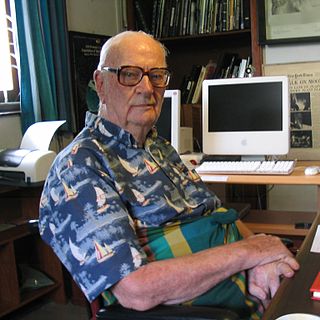
Hard science fiction is a category of science fiction characterized by concern for scientific accuracy and logic. The term was first used in print in 1957 by P. Schuyler Miller in a review of John W. Campbell's Islands of Space in the November issue of Astounding Science Fiction. The complementary term soft science fiction, formed by analogy to the popular distinction between the "hard" (natural) and "soft" (social) sciences, first appeared in the late 1970s. Though there are examples generally considered as "hard" science fiction such as Isaac Asimov's Foundation series, built on mathematical sociology, science fiction critic Gary Westfahl argues that while neither term is part of a rigorous taxonomy, they are approximate ways of characterizing stories that reviewers and commentators have found useful.
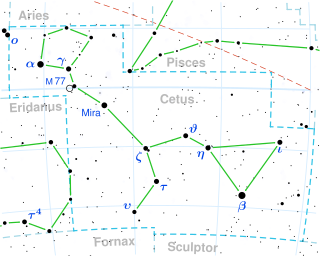
Tau Ceti, Latinized from τ Ceti, is a single star in the constellation Cetus that is spectrally similar to the Sun, although it has only about 78% of the Sun's mass. At a distance of just under 12 light-years from the Solar System, it is a relatively nearby star and the closest solitary G-class star. The star appears stable, with little stellar variation, and is metal-deficient relative to the Sun.

Destination: Void is a science fiction novel by American author Frank Herbert, the first of four novels in the Pandora Sequence series. It first appeared in Galaxy Magazine—illustrated by John Giunta—in August 1965, under the title "Do I Wake or Dream?", but was published in book form as Destination: Void the following year. A revised edition, edited and updated by the author, was released in 1978. The book stands alone but the story is continued - and embellished with more details of the Moonbase project and the history of the clones - in Herbert's other novels The Jesus Incident, The Lazarus Effect and The Ascension Factor, co-authored by Bill Ransom.
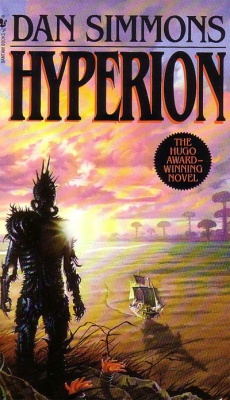
The Hyperion Cantos is a series of science fiction novels by Dan Simmons. The title was originally used for the collection of the first pair of books in the series, Hyperion and The Fall of Hyperion, and later came to refer to the overall storyline, including Endymion, The Rise of Endymion, and a number of short stories. More narrowly, inside the fictional storyline, after the first volume, the Hyperion Cantos is an epic poem written by the character Martin Silenus covering in verse form the events of the first two books.

First contact is a common theme in science fiction about the first meeting between humans and extraterrestrial life, or of any sentient species' first encounter with another one, given they are from different planets or natural satellites. It is closely related to the anthropological idea of first contact

Tau Ceti is a video game published in 1985 by CRL for the ZX Spectrum and converted to the Amstrad CPC, Amstrad PCW, Atari ST, Commodore 64, and MS-DOS. It was designed and programmed by Pete Cooke. The world, set on Tau Ceti III orbiting Tau Ceti, is displayed using 3D graphics with shadow effects. The planet has a day and night cycle.
Stars outside of the Solar System have been featured as settings in works of fiction since at least the 1600s.
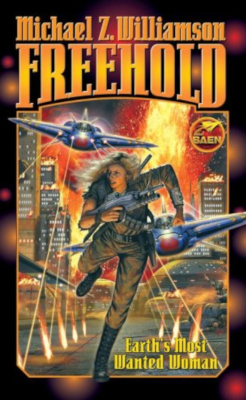
Freehold is a military science fiction novel by Michael Z. Williamson, published in 2004 by Baen Books. The book tells the story of Kendra Pacelli, a young soldier who begins the book in the service of a world-dominant, authoritarian United Nations. Accused of a crime she did not commit, she flees Earth for the Freehold of Grainne where she struggles to adapt to the climate and culture of an ultra-libertarian planet. She eventually joins the Freehold military and fights in a war against a UN invasion.

"The Colorful Character" is a science fiction short story by American writer L. Sprague de Camp, part of his Viagens Interplanetarias series. It was first published in the magazine Thrilling Wonder Stories in the issue for December, 1949. It first appeared in book form in the collection Sprague de Camp's New Anthology of Science Fiction, published simultaneously in hardcover by Hamilton and in paperback by Panther Books in 1953.
Space travel under constant acceleration is a hypothetical method of space travel that involves the use of a propulsion system that generates a constant acceleration rather than the short, impulsive thrusts produced by traditional chemical rockets. For the first half of the journey the propulsion system would constantly accelerate the spacecraft toward its destination, and for the second half of the journey it would constantly decelerate the spaceship. Constant acceleration could be used to achieve relativistic speeds, making it a potential means of achieving human interstellar travel. This mode of travel has yet to be used in practice.
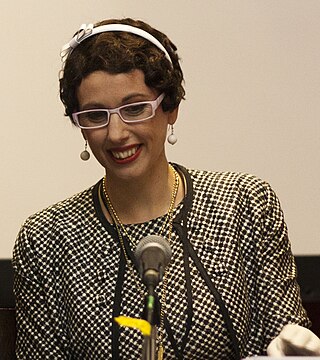
Gail Carriger is an author of steampunk fiction and an American archaeologist. She was born in Bolinas, an unincorporated community in Marin County, California, and attended high school at Marin Academy. She received her undergraduate degree from Oberlin College, a masters of science in archaeological materials at England's University of Nottingham in 2000, and a master of arts in anthropology at the University of California Santa Cruz in 2008. She is a 2010 recipient of the Alex Awards.
The 100 Year Starship project (100YSS) was a one-year joint U.S. Defense Advanced Research Projects Agency (DARPA) and National Aeronautics and Space Administration (NASA) effort "to take the first step in the next era of space exploration—a journey between the stars". The study explored development of a viable and sustainable model for persistent, long-term, private-sector investment into the myriad of disciplines needed to make interstellar space travel practicable and feasible. The goal was to examine what it would take — organizationally, technically, sociologically and ethically — to develop the ability to send humans to another star within 100 years. The study culminated in a $500,000 grant awarded to a consortium under the lead of the Dorothy Jemison Foundation for Excellence, which led to the creation of an independent organization inheriting the name 100 Year Starship from DARPA. Annual 100YSS symposia were organized from 2011 to 2015, and again in 2023.

The Martian is a 2011 science fiction debut novel written by Andy Weir. The book was originally self-published on Weir's blog, in a serialized format. In 2014, the book was re-released after Crown Publishing Group purchased the exclusive publishing rights. The story follows an American astronaut, Mark Watney, as he becomes stranded alone on Mars in 2035 and must improvise in order to survive.

Andrew Taylor Weir is an American novelist. His 2011 novel The Martian was adapted into the 2015 film of the same name directed by Ridley Scott. He received the John W. Campbell Award for Best New Writer in 2016 and his 2021 novel Project Hail Mary was a finalist for the 2022 Hugo Award for Best Novel.

Aurora is a 2015 novel by American science fiction author Kim Stanley Robinson. The novel concerns a generation ship built in the style of a Stanford torus traveling to Tau Ceti in order to begin a human colony. The novel's primary narrating voice is the starship's artificial intelligence. The novel was well received by critics.

Artemis is a 2017 science fiction novel written by Andy Weir. It takes place in the late 2080s in Artemis, the first and so far only city on the Moon. It follows the life of porter and smuggler Jasmine "Jazz" Bashara as she gets caught up in a conspiracy for control of the city.

Darcie Little Badger is an American novelist, short story writer, and Earth scientist.

The Calculating Stars is a science fiction novel by American writer Mary Robinette Kowal. The book was published by Tor Books on July 3, 2018. It is the first book in the "Lady Astronaut" series and is a prequel to the 2012 short story "The Lady Astronaut of Mars".
Tau Ceti f is a confirmed exoplanet that is a potential super-Earth or mini-Neptune orbiting Tau Ceti that was discovered in 2012 by statistical analyses of the star's variations in radial velocity, based on data obtained using HIRES, AAPS, and HARPS. It is of interest because its orbit places it in Tau Ceti's extended habitable zone, but a 2015 study implies that there may not be a detectable biosignature because it has only been in the temperate zone for less than one billion years. In 2017, it was again recovered from radial-velocity data, along with Tau Ceti e.















